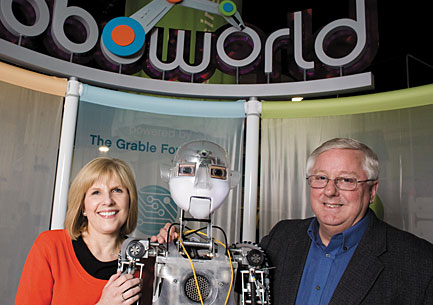 Summer 2009
Summer 2009|
“Simply put, a fascination with robots can be used to motivate youth toward careers in science and technology.”
|
 It was late April, and we were navigating among the half-built displays, wires, tools, and tarps in the second-floor gallery that houses our new roboworld™ exhibit. The painting and carpeting were finished—but there were gaggles of software engineers and robotics specialists working with our own Science Center team to install the myriad of experiences in the gallery. We had a special arrival that day: “Andy,” the robot that greets visitors as they enter roboworld. Andy has a human-like form and voice—but his torso and appendages are cold metal. He talks, he blinks, he gestures to make a point. His purpose in the entry of the gallery is to provide visitors with basic information about robots—and on that particular April day, we were testing him out for the first time. We were charmed. Andy delivered his lines with great pizzazz and drama—telling us about robotic sensing, thinking, and acting. Telling us about Unimate, the first robot to work in an industrial setting, and about all the places we encounter robots in our everyday lives. In the midst of our testing session with Andy, we heard a chorus of small voices yell “Look up here!” We looked upward to see kids and adults lined shoulder to shoulder along the railing on the floor above us, leaning down to see and catch every word that Andy had to say. The kids were yelling to him, not us, because they wanted a little … robot attention. Easy fix: We pushed a few buttons on Andy’s console to make him raise his robot chin and look up to his adoring fans. That day was a small reminder of the deep fascination we all have with robots. But there’s a lot more to it than simple fascination. For more than 20 years, Carnegie Science Center has developed robotics-oriented camps, classes, and educational programming—and we know that the subject of robotics is a natural gateway to introduce and engage children in the fundamental principles of science, math, engineering, and computer programming, all vital to the design and operation of robots. Simply put, a fascination with robots can be used to motivate youth toward careers in science and technology. For the past decade, Pittsburgh, sometimes called “Roboburgh,” has been identified as one of only a handful of locations leading the country in developing cutting-edge robotics technology. Robotics in western Pennsylvania is expected to grow into an estimated $500 billion industry, requiring a new generation of technicians, researchers, and entrepreneurs to support this industry. How can our region develop this next-generation workforce? One way is to engage kids early. We believe that exposing kids to hands-on informal learning opportunities—the kind Carnegie Science Center offers in roboworld and in all of our programs—can provide the spark that ignites the interest of today’s young people in science careers. So Andy’s job as the greeter robot is pretty important. Come meet him yourself —he’s waiting to make some new friends.
|
Also in this issue:
Robots R Us · Honoring Robotic Mettle · An Equal Opportunity Lens · Diva Intervention · A Tribute to Our Donors · NewsWorthy · Now Showing · Face Time: Ellen McCallie · About Town: Teen Tonic · Field Trip: Branching Out · Science & Nature: Harnessing the Horse · Artistic License: Expanding View · The Big Picture
 |
Copyright © 2017 CARNEGIE Magazine. All rights reserved. |


